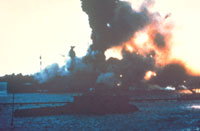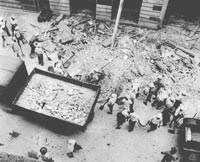|
World
Aviation in 1941
29 January
The Luftwaffe aircraft drop mines into the Suez Canal.
25 February
The Air Defence Force (PVO) is formed in the Soviet Union.
27 March
Following a coup d'etat by anti-Nazi elements in Yugoslavia,
Hitler orders the invasion of both Yugoslavia and Greece.
6 April
The first aircraft ejection seat, a compressed air unit, is
fitted to the German Heinkel He280 jet fighter.
9 April
An agreement is reached between the Danish government in
exile and the United States, allowing the United States to
build and operate airfields in Greenland.
15 April
Igor Sikorsky makes an officially recorded flight of 65
minutes 14 seconds during a demonstration of his VS300 at
Sratford in Connecticut.
May
The Soviet Union brings RUS-1 and RUS-2 air defence radar
sets into service.
10-11 May
Rudolf Hess, Deputy Führer of Germany, flies to United
Kingdom in a Messerschmitt Bf110 and lands by parachute in
Scotland. While the purpose of the flight is still a matter
of controversy, it is thought that when he eventually
identified himself he claimed his mission was one of peace.
13-14 May
The first major deployment of Boeing B17 Flying Fortress
aircraft in the Pacific. The United States Army Air Corps (USAAC)
flies 21 aircraft from Hamilton Field in California to
Hickham Field in Hawaii.
20 June
The United States Army Air Force (USAAF) is formed with Major
General H.H. Arnold as its Chief.
22 June
  Operation
Barbarossa: the German invasion of the Operation
Barbarossa: the German invasion of the
 Soviet
Union, opens with a massive air assault. By nightfall Soviet
losses amount to 1,811 aircraft of which 1,489 were destroyed
on the ground. The Luftwaffe losses are light, with only 35
aircraft destroyed. Soviet
Union, opens with a massive air assault. By nightfall Soviet
losses amount to 1,811 aircraft of which 1,489 were destroyed
on the ground. The Luftwaffe losses are light, with only 35
aircraft destroyed.
22 June
At 0430hrs Lieutenant Kokorev of the 124th Fighter Regiment,
Red Air Force deliberately rams a German Messerschmitt Bf110.
This is the first recorded instance of a battering ram attack
during the Second Word War.
21-22 July
Lufwaffe bombers make their first night attack on Moscow.
1 August
The first use of Soviet 'parasite' Polikarpov I16SPB dive
bombers, a variant of the standard fighter, carried under
wings of the Tupolev TB3 heavy bomber, occurs during a
successful attack on Constanza in Romania.
1 August
The United States bans the export of aviation fuel, except to
the United Kingdom and unoccupied nations. This comes as
severe blow to the Japanese and their continuing war in
China.
7-8 August
A small force of Soviet Naval Aviation Il-4 (DB3F) bombers
takes-off from Estonian Islands of Dagö and Saaremaa and
attacks the Berlin area. The city was brightly lit and the
raid precipitates the introduction of blackout regulations in
the German capital.
18 August
President Roosevelt announces that Pan American World Airways
(Pan-Am) is to ferry United States-built warplanes to British
forces in the Middle East.
September
The first operational use of Soviet Polikarpov U2 biplanes as
'night harassment bombers'.
14 September
Messerschmitt Me321 heavy assault transport gliders
(sailplanes) of Staffel [GS] 1 are used for the first time in
an operational air assault on Saaremaa island in the Baltic,
as part of an attempt to capture the fort of Kübarsaare.
16 September
The Luftwaffe begins leaflet raids on Leningrad, threatening
immediate destruction unless the city surrenders.
23 September
A Junkers Ju87 pilot, Oberleutnant Hans-Ulrich Rudel,
succeeds in hitting the 26,170 ton Soviet battleship Marat at
Kronstadt with a 1,000 kilo bomb. The ship is badly damaged
and sinks in shallow water in what is probably the greatest
success achieved by a dive bomber pilot in the Second World
War.
30 September
The Luftwaffe claims to have destroyed more than 4,500 Soviet
aircraft since the opening of hostilities.
2 October
The third prototype of the Messerschmitt Me163A rocket
fighter, piloted by Heini Dittmar, achieves a speed of
1,004kph (623mph), an unofficial world speed record that
remains a secret until the end of the war.
30 October
A Consolidated B24 Liberator, with Major Alva L. Harvey at
the controls, completes a round-the world flight, carrying
personnel of the Harriman Mission.
1 December
The United States Civil Air Patrol is established to make use
of American civilian pilots and their aircraft for wartime
duties.
 7
December 7
December
The principal United States Naval Base in the Pacific, at
Pearl Harbour in Hawaii, is attacked by Japanese
carrier-borne aircraft at 0755hrs local time (1825hrs GMT).
On the evening of 7 December, it is announced in Tokyo that
Japan is at war with the United States and Britain.
8 December
The United States declares war on Japan.
 8
December 8
December
Following heavy air attacks on Royal Air Force (RAF) bases in
Malaya and Singapore, the Japanese invade northern Malaya.
The United Kingdom declares war on Japan.
10 December
After a heavy air attack on Cavite naval base in the
Philippines Japan begins small amphibious landings at Aparri
and Vigan in Northern Luzon.
10 December
United States Army Air Force (USAAF) Boeing B17 Flying
Fortress bombers, operating from the Philippines, attack
Japanese shipping. This is the first American air offensive
action of the Second World War.
11 December
Germany and Italy declare war on the United States.
18 December
Following the destruction of his fifth Japanese aircraft over
the Philippines Lieutenant 'Buzz' Wagner of the United States
Army Air Force (USAAF) becomes the first American 'ace' of
the Second World War.
20 December
The German Air Ministry instructs work to begin on the
Amerika-Bomber project, with the intention of developing a
bomber with transatlantic capability.
28 December
Australian National Airlines begins evacuation of civilians
from Rabaul in the Solomon Islands.
Also this year...
The Russian Ilyushin
Il-2 becomes the first aircraft to be armed with
air-to-ground rockets. |
